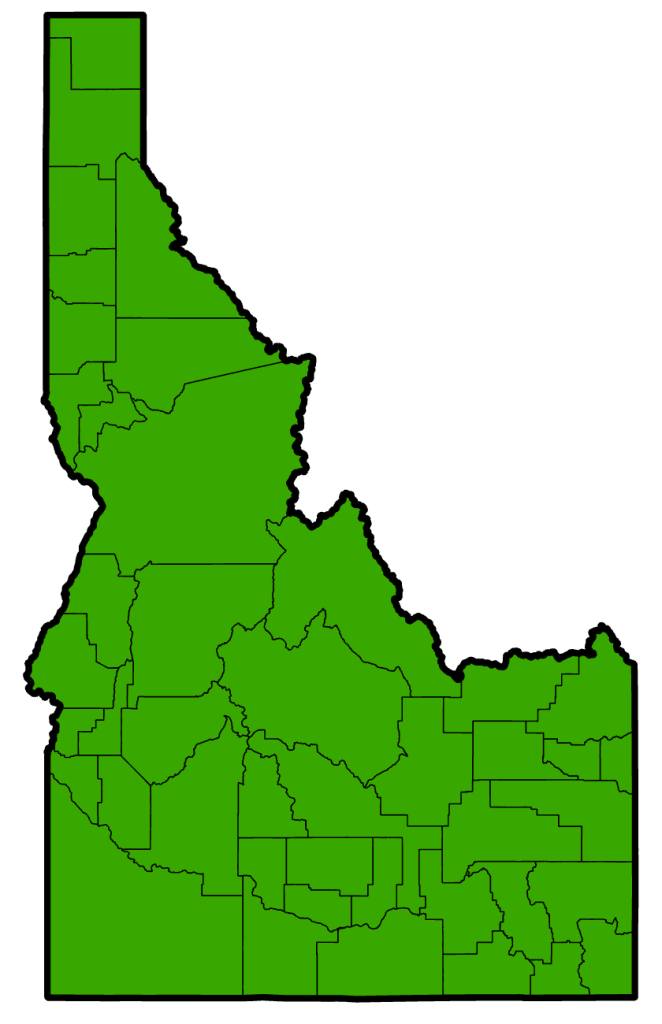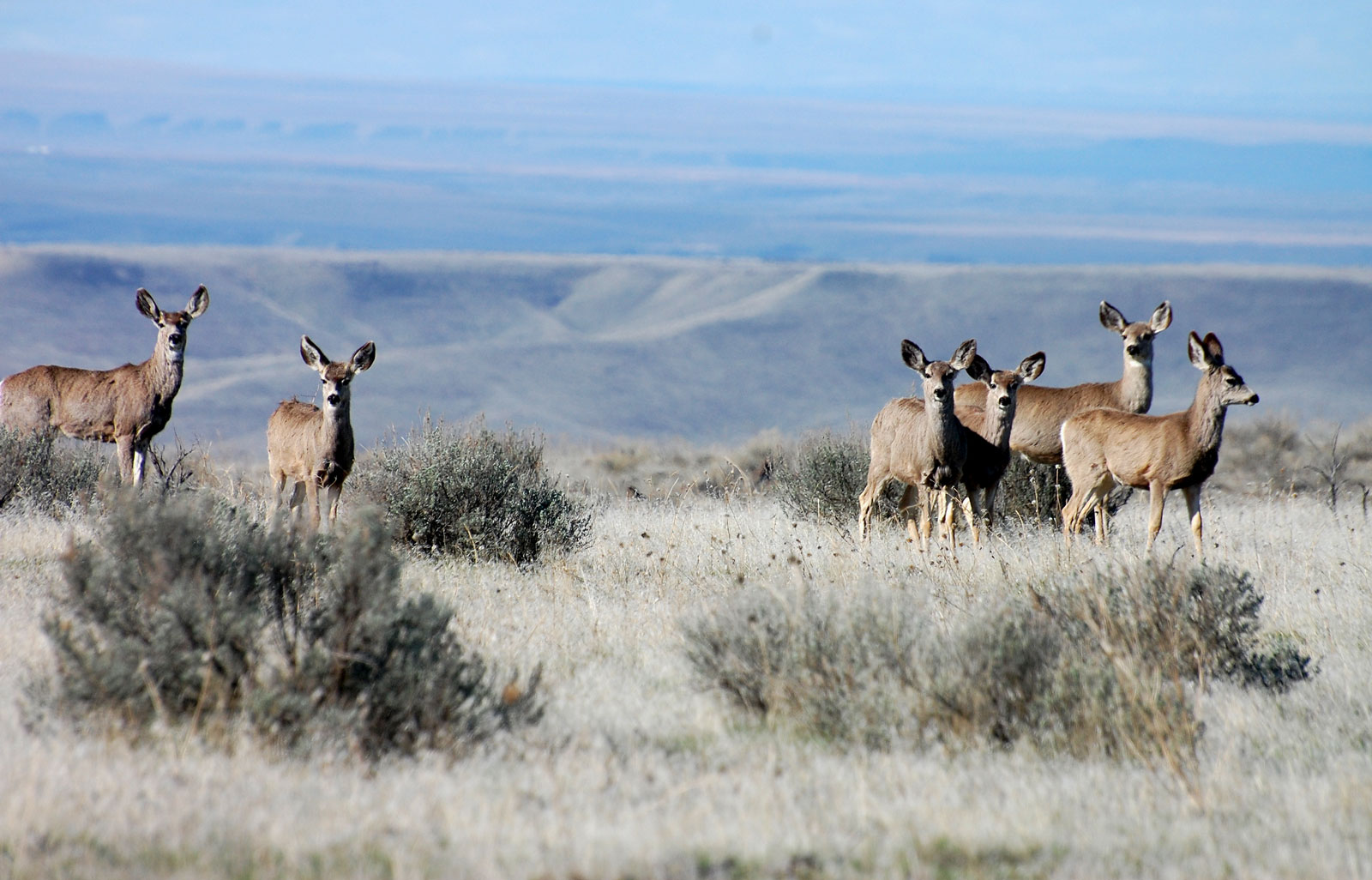Idaho’s most common large mammal is the mule deer (Odocoileus hemionus). The deer’s scientific name reflects one of the animal’s most recognizable features – its large ears. Hemionus means half-mule.
Idaho has two species of deer – the mule deer and the white-tailed deer. Mule deer are the larger of the two deer species in Idaho. In central Idaho, mule deer are by far the more common of the two species.
A mule deer buck averages about 250 pounds and develops antlers that grow in a branching pattern. The better the quality of food a buck eats the healthier he will be and the larger his antlers will grow. Interestingly, you cannot tell how old a buck is by the size of his antlers. Does, or female mule deer, are smaller, averaging about 155 pounds.
Mule Deer Characteristics
- White rump
- White, rope-like tail with black tip
- Antlers (on older males) branch equally, often ending in a “V”
- Large mule-like ears
- Long slit-like gland on hide legs
- When startled, jump on all 4 legs, called “stotting”
- Can be found in every habitat type in southern Idaho, from the alpine to the canyon lands
White-tailed Deer Characteristics
- Large brown tail brown with white fringe, white underneath
- Antlers (on older males) have a main beam with tines pointing upward
- Small ears
- Short slit-like gland on hind legs
- When startled, will lift tail and show white “flag” when running
- In southern Idaho, associated with lower elevation, riparian corridors near ag fields
Where you find mule deer depends a lot on the time of year. Many mule deer populations in the state are migratory, with some deer making 100+ mile journeys between summer and winter range. Forbs and grasses provide important nutrition for deer, particularly in spring and summer. Migrating mule deer follow their food up in elevation as it greens up in the spring – this is called “surfing the green wave.” During the spring, summer and fall mule deer may be found on mountain slopes, especially in aspen stands where shrubs, flowering plants (forbs) and grasses grow. Aspen stands can provide high quality forage for mule deer with the added bonus of hiding and thermal cover. Aspen communities have long been described as critical fawning and summer habitat for mule deer, because they often contain a rich diversity of forbs, grasses, and shrubs that provide cover and forage.
Does with fawns may be found around aspen tree groves which due to their rich vegetation are especially important for lactating females, while the trees offer shelter for fawns. Summer and fall nutrition are critically important for mule deer. It has been shown that deer going in to winter in good condition are more likely to survive, even if the winter range is poor. However, deer in poor condition before winter are unlikely to survive, even on high-quality winter range.
In the fall, mule deer will move down from higher mountain elevations into lower elevation valleys and south-facing hillsides to escape deep snow. During the winter, deep snow can make it very difficult for mule deer to access food, as well as increase energy expenditures. Snow depth and condition is one of the main drivers of mule deer survival in most areas of Idaho.
Impacts to mule deer populations
Because mule deer populations are more prone to seasonal fluctuations than elk, the state does not have a statewide estimate of mule deer.
Predators, like mountain lions, can impact deer populations when lion numbers are high or environmental conditions make lions more efficient predators. Environmental factors may cause deer to concentrate due to deep snow or drought conditions which often force deer to migrate to available water sources.
While predators do play a role in affecting deer populations, there are other significant factors to consider when looking at impacts to mule deer populations.
– Winter range lost to human activities such as housing and energy developments (link to current projects)
– Summer and winter ranges negatively affected by wildfires
– Prolonged drought or harsh winters
– Increased elk populations moving on to mule deer habitat
– Invasive plants impacting native plant communities within critical deer habitat (link)
– Disease (link)
Urban deer populations
Mule deer are increasingly living in Idaho’s cities and towns, and can be seen throughout the year in the Wood River Valley. As the state’s human population continues to grow and encroaches on previously undeveloped deer habitat, urban deer conflicts are expected to become more prevalent.
Deer quickly learn life within and near our communities has many advantages. With few natural predators, restrictions or prohibitions on hunting and discharging firearms, steady food supplies, and little or no need to migrate, many sources of mortality are virtually eliminated for these deer. As urban deer populations increase and generations of females teach fawns to survive in our towns, vehicle collisions and nuisance complaints increase, and predators, such as mountain lions arrive to take advantage of ample prey.
Some Wood River Valley residents see deer as a nuisance, while others continually feed them and enjoy their presence. This situation can, and does create neighborhood conflicts, as habituated deer with no fear of humans or pets do not differentiate between tolerant residents and those who want to avoid damage to gardens, shrubs, and trees.
Predators, especially mountain lions who’s preferred prey source is deer, can also be attracted to areas with high densities of urban deer, and mountain lion presence often incites fear and concern among local residents.
Please don’t feed the deer
Mule deer are highly selective foragers, in part due to their specialized digestive system. A mule deer’s digestive system is similar to other ruminants, who have four stomach compartments, instead of a single stomach. Deer, are dependent on bacteria to break down their food. As their diets change throughout the year, so do the bacteria, adjusting to differences in diet composition and the quality of the forage. Changes in bacteria can take several weeks; therefore deer are poorly adapted to sudden changes in diet. As a consequence, even foods with high nutritional value may become difficult or impossible to digest, and animals will often die with full stomachs. If feeding is deemed necessary, IDFG purchases specially formulated feed for mule deer in winter.
Include range distribution map/images

